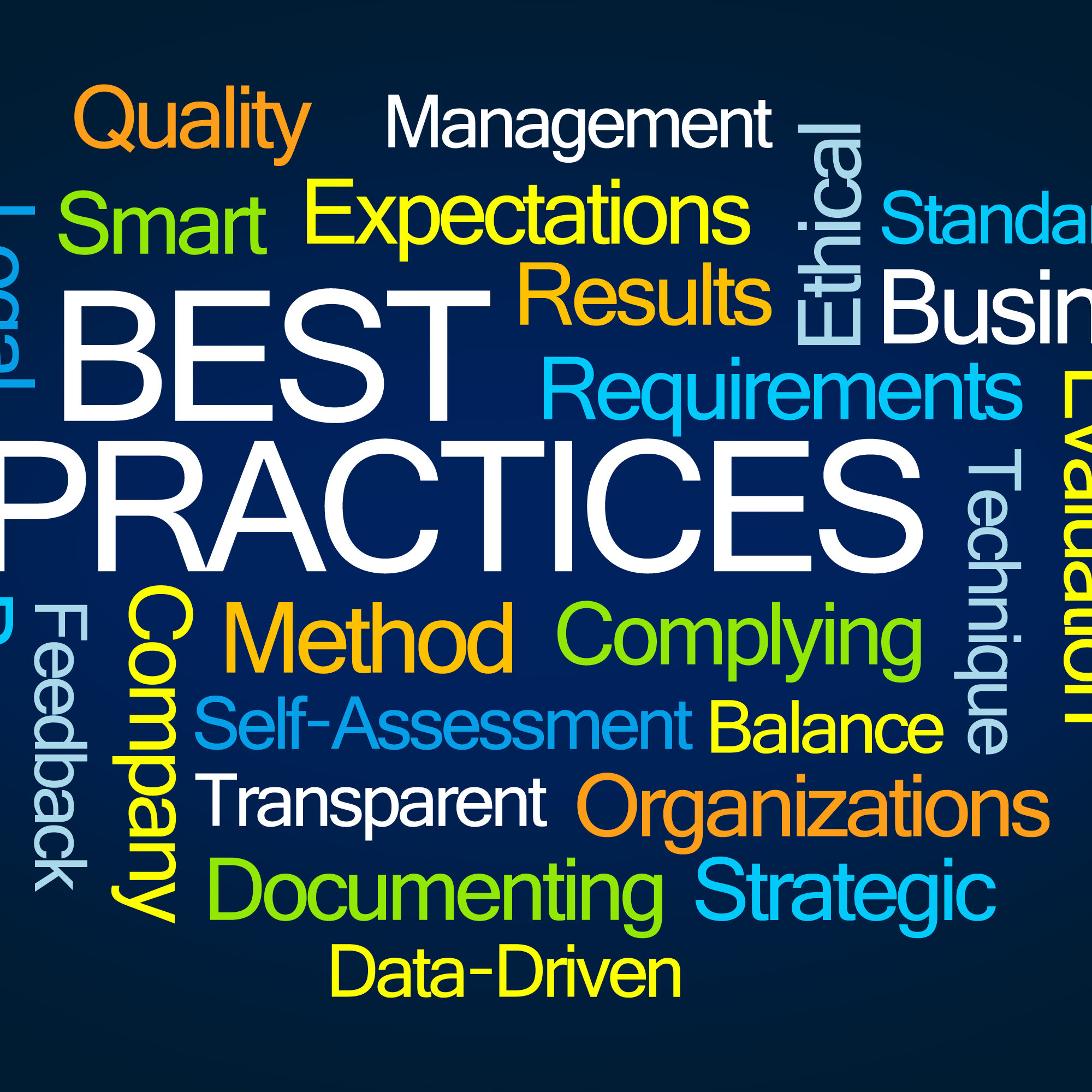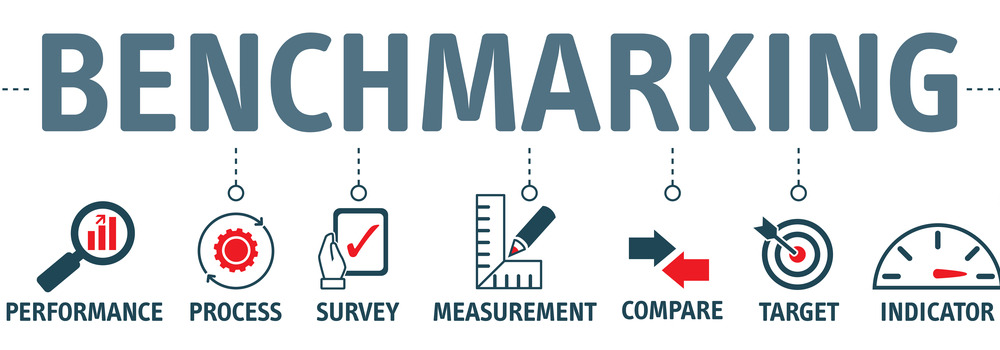When you use a call center, you are often told that the “call might be recorded for quality control purposes.” At the end of your transaction, you may be asked if you would be willing to take a short survey about your experience with their service and, if so, if you would please stay on the line. What is this about? The company is probably collecting data about things like:
- call wait time
- problem resolution
- your overall satisfaction with the encounter
They will generally use the data in a procedure called HR benchmarking.
HR benchmarking is a process used to compare similar characteristics across organizations to identify milestones. It’s sort of a compare and contrast system of determining success and best practices. When HR professionals have data for comparison purposes, they are better able to set goals and objectives for their own company. Read on to learn more about benchmarking and what it means for organizations.
Related Resource: 20 Companies With the Best Benefits
What is Benchmarking in HR?
Benchmarking for specifically HR purposes involves looking at the policies and practices of one organization, then comparing and contrasting those with another similar organization. A benchmarking approach should focus on best practices, or the things organizations are doing that consistently lead to successful results. In order for an understanding of best practices to be obtained, benchmarking activities must be planned strategically with particular goals in mind. By identifying in advance the types of patterns and data they are seeking, HR professionals can then create a benchmarking HR system that is more reliable and valuable.
Benchmarking and Risk

The Emergence of Benchmarking
Many people who study business trends connect the emergence of benchmarking with the widespread availability of the computer about three or four decades ago. Consulting firms grew into prominence at the same time along with the globalization of industry. Obviously, competition on a worldwide basis creates a large database and an increased need to know where the performance of one company ranks in comparison to another.
Types of Benchmarking in Human Resources
The two main types of benchmarking are internal and external. While this article looks at HR benchmarks for department procedures, it is also used in many other business arenas.
Internal Benchmarking
This human resource benchmark refers to comparing two aspects of an organization. A simple example might be the comparison of the functioning of two employees in terms of productivity and quality of performance. They may study the overall employee experience to look at similarities and differences. Departments can also be compared to one another to see which has the highest profit ratio.
External Benchmarking
This comparison is between competing organizations. Using measurements common to both (or to all), the benchmarking business can see numerically where they rank. They may, for instance, be in the top twenty-five percent or perhaps just below average when compared to the top-performing business surveyed.
Further Delineation
If external and internal benchmarking are the trunks, the branches of this process are different kinds of measurements and target organizations.
Process Benchmarking
This type of benchmarking looks at the HR metrics (or statistics) concerning one or more of a company’s processes and how they compare to the processes of other top-rated organizations. In HR departments, for example, it might involve looking at ways an employee is on-boarded and whether that process aids in retention.
Competitive Benchmarking
While the process benchmark looks at one aspect of an organization, the competitive benchmark procedure studies overall performance of the organizations involved.
Performance or Functional Benchmarking
This compares how well an organization is achieving its goals. That may be in terms of profit/loss statistics, customer satisfaction or other measurements of success. In terms of HR departments, this can be an internal or an external procedure, as the HR department can be compared to other departments such as quality assurance in the organization. It may also, however, be compared externally to the HR departments of other organizations in things such as net promotion scores for the employer.
Benefits of Benchmarking
Human resources benchmarking can provide some useful and quite powerful information. When looking at similar organizations, a lot can be determined through HR benchmark comparisons. HR pros can see where gaps exist within certain practices. Which policies are working well and which may be causing problems can also be identified. As can issues within such areas as hiring, training, and promotion. Specific issues such as sick time, turnover rate and discipline can be examined separately. This is helpful when attempting to identify patterns for future use.
Some Cautions About Benchmarking
As helpful as human resources benchmarks are to the process of growing or improving a business, an article in Forbes Magazine identifies some negative aspects of the procedure.
Immediacy of Data Sets
Quantitative and qualitative data used in benchmarking sometimes takes several years to collect and interpret. That means companies may be making inferences based upon data that is several years old and possible no longer relevant. The speed at which data accumulates and changes is constantly increasing.
Adopting a “Best Practice” Takes Time
Once a deficiency is identified, it takes time for organizations to rethink how to adapt to them and how to retrain employees to the adaptation. That can take months or even years, so while your new program may be based upon “best practice,” it could well be the best practice of years past
Technology Advances
The rapid pace at which technology is advancing makes lengthy adaptation to patterns of success difficult. Instead, many managers and CEO’s are using a procedure known as Pushing Boundaries. While benchmarking involves looking at the performance of other organizations in proven tracks, pushing boundaries is adaptive and deals in timely ways with events such as the Covid-19 pandemic that resulted in the demise of so many businesses.
Best Practices in Benchmarking
Best practices in benchmarking revolve around identifying a particular strategy. It’s critical that professionals determine what it is they wish to learn prior to undergoing any data collection. Otherwise, it’s likely they will waste time and resources obtaining information that proves to be useless. It’s also important to ensure comparisons are being made between very similar variables. For example, it isn’t very worthwhile to compare the salaries of a large corporation that’s been in business for decades with those of a small startup. While the purpose in benchmarking is to identify best practices within HR, it’s also necessary that best practices within the field of benchmarking be utilized in order to gain the most success.
Tips for Successful Benchmarking
As noted, it’s most important to define in great detail the process, activity or attribute to be benchmarked. If the outcome isn’t defined, the search can tend to go off track. Then, the measurements must be determined. It’s imperative to know what units of measurement are to be used in order to be sure of gaining clear results. Data collection comes next, with precise information being obtained from the organizations being studied. Again, be sure to choose organizations that are similar in attributes. Look for glaring disparities or gaps among the data and then look for the underlying causes of these. Once the cause is analyzed and correctly determined, begin to create an continuous improvement plan and set goals in accordance. This plan must be communicated to all stakeholders. Then, after a specific timeframe, measurements should be taken to determine if the gaps have been closed. A report is usually written to disseminate the benchmarking results.
The Outcome of Successful Benchmarking
The great thing about the benchmarking process is that it is structured. While it does not result in grand innovations, it does provide a plain path toward proven success. That is key to benchmarking. It will always have an infrastructure, a “highway” system, that makes possible the transition from point “A” to point “B” just like interstate highways make travel faster and easier. The units of measure mentioned above will depend upon the areas of comparison. They may be quantitative or qualitative. Narrowing down the issue of study is important as well. Deciding to visit Mount Rushmore instead of a national monument will result in a much more selective (and manageable) data field. Analysis of that data field will show any disparities between the organizations involved in the process. Just knowing what is different, however, will not make the process successful.
The next step is strategizing how to address those disparities. That strategy must include considering things that could hinder adaptation. One of the primary hindrances, especially in HR departments is the tendency of employees to resist change. They may have to be retrained or even moved to different departments. Benchmarking can show where resources are not being well-used too. Current thinking stresses the value of human capital over material or financial resources, and it is crucial to utilize them to their (and the corporate) advantage.
Another area benchmarking spotlights is weak areas that have the potential for change. That means looking at things like:
- machinery replacement
- upkeep
- safety
Sometimes it isn’t cost-effective or even possible to make a change. Where it is, however, benchmarking reports can be the basis upon which a department within a company may request resources to make the change successful.
From the General to the Specific
We have discussed the “big picture” of benchmarking, but now it is time to narrow our field of vision to the topic of this article: HR benchmarking. The Business Benefits Group website defines benchmarking in HR as the “process of measuring and comparing human resource policies and practices with those of other organizations.”
Internal benchmarking for the HR department can identify where resources are duplications of services or even where tasks can be done faster and easier by technology. For instance, the call at the beginning of this article may have been answered by a human, but robot technicians may have taken over to solve the issue. That means the human operator can handle more calls during a shift, and that results in requiring fewer employees. Benchmarking of other successful organizations can point out productivity differences that may show whether an employee is meeting the expectations of his job.
External benchmarking for the HR department compares the performance of a business to another company and involves the touchy issue of creating alliances and ferreting out public financial information. It can pinpoint areas where the business falls short of the performance of the competition.
As HR departments identify these performance gaps, they can save the company money by lowering labor costs. So, even though benchmarking does not immediately support innovation, it does help organizations acquire the financial resources to explore new technologies and procedures. Improving customer service and experience can drive up sales and profits. This, combined with the lowered labor costs, can give businesses a huge boost in their ability to stay competitive, even in a global market.
The operative words in the above sentence are “can give.” Benchmarking is a tool. It is valuable for many types of operations and can be adapted to the use at hand. It can show a corporation where it falls on the performance spectrum of like businesses. Similar to a child taking apart a toy truck to see how it works, corporation HR departments can dissect:
- recruiting and hiring policies
- trainings and incentives
- compensation and benefit packages
- on-boarding procedures
- handling of compliance and legal issues
Just knowing where they fit, whether in the middle, top tier or below average, is not the goal of benchmarking, however. Companies must learn from the data, engage in strategizing and make changes to achieve the goals they have set for themselves.
Conclusion
Benchmarking is a complex process that helps organizations to improve upon their policies, practices, and products. HR benchmarking is specific to the field of human resources and is used to examine best practices within departments.
Related Resources:
- Top 50 Best Online Master’s in HR Degree Programs (MSHR)
- 5 Ways Benchmarking Can Help Your HR Department
- What are Some Electives for a Bachelor’s in Human Resources Student?
- What are Some Good Entry Level Human Resources Jobs?
- What are Some Good Internships for Human Resources Majors?
- 15 Best HR Associations for Human Resource Professionals
- 50 Most Affordable MBA Human Resources Degree Programs 2022
- What is a Process Audit?
Source:


